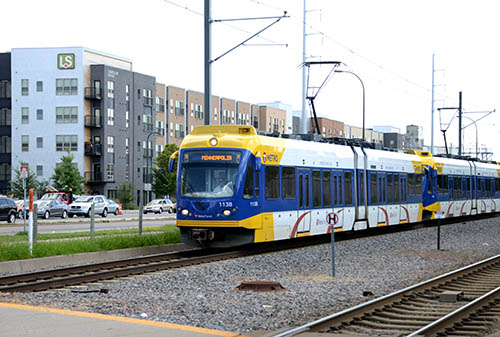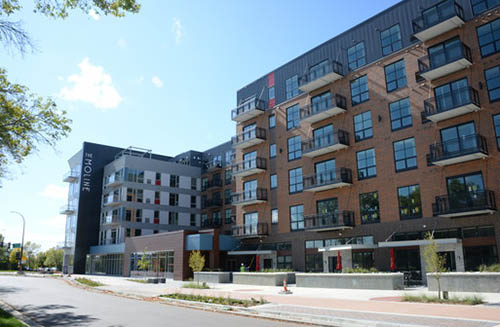Interest in building along high-frequency transit routes is shaping regional development trends, and will continue to do so, according to a report by Metro Transit’s Transit Oriented Development Office.
The report found that around one-third of the region’s residential multifamily development between 2009 and 2017 happened within a half-mile of current and planned light rail and bus rapid transit stations. That’s roughly 15,000 new housing units.
Transit extends the urban core
Sherman Associates is one Twin Cities developer that chooses to build residential multifamily properties along transit.
 “We’re always looking for what things are going to keep our buildings full and keep people wanting to pay a competitive rate to live there,” said Shane LaFave, director of multifamily development. “And, being located next to transit is one of those big boxes you can check.”
“We’re always looking for what things are going to keep our buildings full and keep people wanting to pay a competitive rate to live there,” said Shane LaFave, director of multifamily development. “And, being located next to transit is one of those big boxes you can check.”
LaFave pointed to about 20 projects that developers have already started or are in the works on the METRO Green Line Extension, even though that line isn’t built yet. “The reason that we like developing on transit lines is because we see it as the extension of the urban core. We’ve really tried to focus on light rail stations and, now, bus rapid transit lines are coming.”
The report points out that there has been far more development along the METRO Blue Line and Green Line than the two bus rapid transit lines included in the study. LaFave acknowledged that development along these lines may take a little more time and education.
“I think that bus rapid transit will make a difference eventually,” said LaFave. “People don’t know what bus rapid transit is yet. Getting people up to speed on what it really is isn’t there yet.”
Bus rapid transit will provide faster, more frequent, and reliable service for millions of people across the metro area. If the additional funds proposed by Gov. Walz are approved, the region is looking to add one rapid bus line a year for the next decade.
As those lines develop, developers, including Sherman Associates, will continue to evaluate potential development with an eye to transit, said LaFave. “It fits our vision, it fits our goal and people seem to desire those buildings.”
Building community on the Green Line
The value of developing housing, businesses and other amenities along high-frequency transitways comes from the accessibility it provides residents, customers and employees, the report concluded.
 Springboard for the Arts took these factors into consideration when the organization began searching for a new space. “When we decided we wanted to start looking for a new location that we could own, being on the Green Line was kind of a non-negotiable,” said Executive Director Laura Zabel. “That was one of our biggest priorities was not just to be near it but we wanted to be on it.”
Springboard for the Arts took these factors into consideration when the organization began searching for a new space. “When we decided we wanted to start looking for a new location that we could own, being on the Green Line was kind of a non-negotiable,” said Executive Director Laura Zabel. “That was one of our biggest priorities was not just to be near it but we wanted to be on it.”
The convenience and visibility of the new SpringBOX! site has already brought value to the organization, even though the doors aren’t open yet. In partnership with the city, organizations and neighbors, they’ve hosted projects, workshops and events that have brought more people in.
“Part of why the events and trainings we’ve hosted at that space have been so popular [is the location] is so accessible, people know where it is, they know how to get there, it feels really visible, and has this really porous relationship with the street and the neighborhood,” Zabel said.
And, the organization looks forward to seeing how that grows when they fully transition to their new space late 2019 or early 2020. “Having been involved during the (Green Line) construction and in the organizing work in the neighborhood, it makes it all the more exciting for us to be a more permanent part of the neighborhood,” she said.
Springboard for the Arts thinks of creativity and culture as a natural resource that exists in every community. The organization is the infrastructure that helps communities and neighborhoods tap into and take care of that resource.
Development means investment in community
Just as Springboard for the Arts chose to locate on transit, between 2003 and 2017, about a third of the region’s commercial development was within a half-mile of current and planned light rail and bus rapid transit stations — that’s around $3.7 billion worth of investment.
“It’s important to remember that, more than the dollar amount, this represents more community members, residents and jobs along transit,” Associate Planner Michael Greif said. “That allows the region to grow more efficiently and for Metro Transit to accomplish its mission.”
Greif analyzed the data, which relied on building permit information collected by the Council. Transitways included in the study include the METRO Green Line, Blue Line, A Line, Orange Line and extensions of the Green and Blue lines.
As the Twin Cities region continues to grow in the coming decades, the report concluded, the amount of development that occurs along transit will be an important indicator not only of the effectiveness of transit but of the region’s ability to grow efficiently.
More information about transit-oriented development